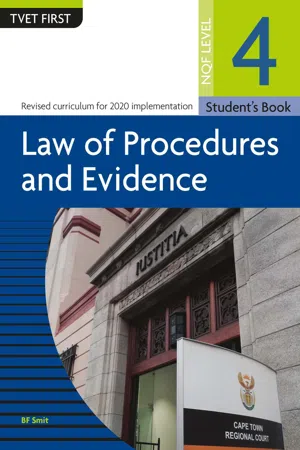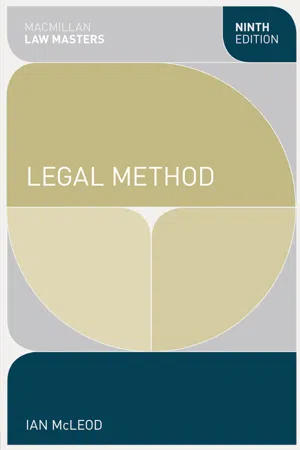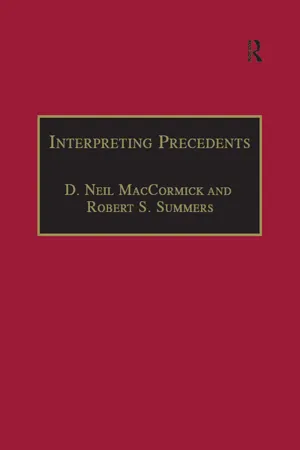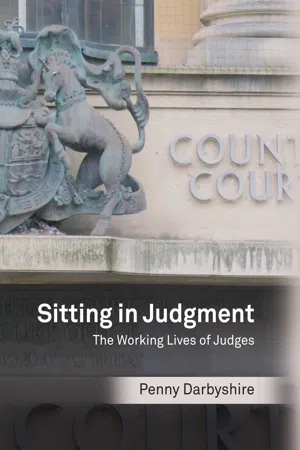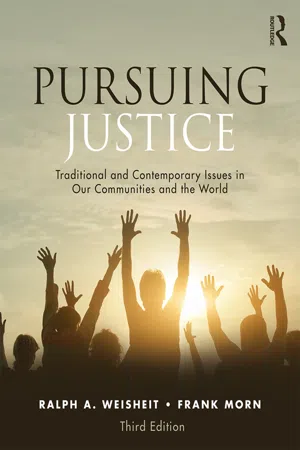Law
Court of appeal
The Court of Appeal is a higher court that reviews decisions made by lower courts. It primarily focuses on reviewing the application of the law and ensuring that legal procedures have been followed correctly. The Court of Appeal does not typically re-evaluate evidence or hear new witnesses, but rather assesses whether the lower court made errors in applying the law.
Written by Perlego with AI-assistance
Related key terms
1 of 5
7 Key excerpts on "Court of appeal"
- eBook - PDF
Law of Procedures & Evidence NQF4 SB
TVET FIRST
- BF Smit(Author)
- 2019(Publication Date)
- Macmillan(Publisher)
File your work in your Portfolio of Evidence. review: to look at or examine again; in law, a review is about the legality of a case, not its merits; reviews focus on the process of a court case leading to an outcome, i.e. the decision itself appeal: to apply to a higher court than the court that passed judgment or sentence to have that judgment or sentence overturned or amended; in law, an appeal is about the merits of a decision (the outcome or the decision itself) and not the process recourse: to be able to turn to, for example, an institution or higher court for help (called ‘relief’) concurrent jurisdiction: having the same power to decide a particular type of case merits of a decision: a decision on the merits is a decision based on the evidence and not on technical or procedural matters New words 157 Module 9 Review and appeal distinguished Review An accused tried in a lower court who is of the opinion that any part of the proceedings in that court was irregular ( not done according to the correct procedures ), and that this irregularity resulted in a failure of justice, may apply to the High Court to have the proceedings reviewed . l If the trial took place in a magistrate’s court and the sentence that was imposed exceeded certain prescribed limits, the case is automatically sent to the High Court for review. l If a court that reviews a case is satisfied that a failure of justice did not result, it will confirm the conviction and sentence. l However, if it is of the opinion that a failure of justice has resulted, it may: ¢ Set aside the conviction and/or sentence and replace it with a proper conviction and/or sentence. ¢ Refer the case back to the trial court to impose a new sentence or for a retrial. In the case of a retrial, the new trial will be held before a different magistrate. - eBook - PDF
The Law Lords
An Account of the Workings of Britain's Highest Judicial Body and the Men Who Preside Over It
- M. Barrett(Author)
- 2000(Publication Date)
- Palgrave Macmillan(Publisher)
In any event, with his appointment to the Court of appeal the prospective Lord of Appeal is only one step away from the very apex of the judiciary. Already as one of the most senior judges in the United Kingdom he wields enormous influence. What he says will be closely scrutinised by legal academics and practitioners in the United Kingdom, by the media of course, and by the many lawyers and judges in the huge number of countries which were once in the British Empire, which have adopted the English legal system (including its unwritten corpus of judicially fashioned laws known as the ‘common law’), and which still rely to some extent on decisions of the English superior courts (the more superior the better) when seeking to determine what way the wind is blowing in so far as the development of the common law is concerned. Membership of the Court of appeal, like membership of the High Court, carries with it the right to wear a fantastically elaborate set of ceremonial robes: black silk gowns decorated in gold lace and worn 34 The Law Lords over a morning suit, a waistcoat and a fine pair of knee breeches. The breeches are tucked into a pair of white socks or tights depending on the individual judge’s preference. The outfit is crowned by the ever popular shoulder-length wig but perhaps most distracting is a fine pair of gold buckled black court shoes. These clothes are so rarely worn, so expensive and presumably so difficult to replace that they are normally passed on from one Court of appeal judge to another, with a plain black gown and a short bench wig being worn on a normal day in court. Ordinary judges in the Court of appeal are known as Lords Justices of Appeal which can be a little confusing as they are not normally members of the House of Lords. That said there is always one member of the Court of appeal (and often two) with a seat in the House. - eBook - PDF
- Ian McLeod(Author)
- 2020(Publication Date)
- Red Globe Press(Publisher)
This is, of course, in clear contradistinction to the Attorney-General’s Reference procedure under s. 36 of the Criminal Justice Act 1972 following an acquittal, where the opinion of the Court of appeal does not affect the outcome of the individual case. Court of appeal (Civil Division) The Court of appeal (Civil Division) deals almost entirely with appeals from County Courts and the High Court. Appeals are said to be by way of rehearing, but in the vast majority of cases only documentary evidence, supported by the oral arguments of counsel, is received in practice. The procedure, therefore, is not the same as the full rehearing which takes place on an appeal from a magistrates’ court to the Crown Court (see page 46). Judicial personnel of the Court of appeal The Lord Chief Justice is not only the Head of the Court of appeal (Criminal Division), but is also both the Head of the Judiciary and the President of the Courts of England and Wales. The Lord Chief Justice is referred to in writing as, for example, Lord Green CJ or, with a hint of tautology, as Lord Green LCJ. The head of the Court of appeal (Civil Division) is the Master of the Rolls, who is also the Head of Civil Justice. The Master of the Rolls is referred to in writing as, for example, Sir James Brown MR or Lord Brown MR. Historically, a peerage was usually conferred but in future the designation ‘Lord’ is likely to be only a courtesy title. An ordinary judge of the Court of 3.7.3 3.7.4 Legal method 54 Appeal will have the title of Lord or Lady Justice of Appeal. The written form of the style is, of course, sexually non-specific, and appears as, for example, Grey LJ. On retirement from the Court of appeal, judges sometimes return to judicial work on a part-time basis to help out with heavy workloads. Under these circumstances they will simply be referred to, both orally and in writing, in terms of the knighthood (or damehood) which they already possessed before retirement: for example Dame Jane Grey. - eBook - ePub
Interpreting Precedents
A Comparative Study
- D. Neil MacCormick, Robert S. Summers, Arthur L. Goodhart, D. Neil MacCormick, Robert S. Summers, Arthur L. Goodhart(Authors)
- 2016(Publication Date)
- Routledge(Publisher)
In all the British jurisdictions, the decisions of appellate courts are reached by majority decision, and each judge states his or her own opinion on the matter. There is always a leading opinion for the majority view and very frequently other members simply state their concurrence in that opinion; but in difficult or complex cases, or where there is agreement in outcome but not in reasoning for that outcome, appeal judges may and quite frequently do give concurring opinions offering their own analysis of the case and of the reasons in favour of the decision handed down. Dissenting opinions are also permitted, and quite frequent. Hence disagreements among the higher judiciary about the proper interpretation or development of the law are open and public. Over time, judicial opinion as to the desirability of working out a single opinion of the court, or of the majority, has varied. The matter remains one for the judges of each generation to settle for themselves – parliament has never legislated, or contemplated legislating, upon this.Case loads per year (1995) are as follows: House of Lords, 72 appeals presented, 67 determined, 81 pending; Court of appeal (England and Wales): Civil Division, 2504; Criminal Division, 2586 (1760 against sentence); Scotland: Court of Session, Inner House, 202; High Court of Justiciary (appeals) 3409.1(c) Power to Select CasesIn general, appeals to the intermediate level are as of right. In criminal matters, there are some filters to cut out frivolous or legally inept appeals. At the highest level, the House of Lords, appeals must be by leave of the intermediate appeal court except in the case of the Court of Session (though there are some special cases where first instance courts can refer matters directly to the House of Lords), or by leave of a subcommittee of the House. Whoever gives leave to appeal, it should be on the ground of there being a point of difficulty in law which it would be advantageous to have settled by the highest tribunal, or which is only capable of being settled at that level. Examples of the latter would be a conflict of binding precedents from lower jurisdictions, or a need to produce a common doctrine for all parts of the UK in place of a divergence in the precedents observed in different countries.2 Structure, Content and Style of JudgmentsA typical judgment or opinion in a UK court has the following form. It will start off with a description of the facts which will in most instances be fairly detailed. After this will come a discussion of what the legal issues arising are, having regard to what the parties to the case want. In appellate judgments, there will usually be an outline account of the proceedings in the court(s) below. There will then follow discussion of these issues, arguing towards a conclusion about the binding law on those points on which it is deemed relevant or necessary to make a ruling. Where other points have been argued, there may be a statement that it is unnecessary to reach any conclusion on these, though it is not uncommon for judges to state an opinion on such a matter, though with disclaimer of any intention to settle that point authoritatively at this stage. In lower courts, where judges consider the matter capable of being settled by reference to only one or two points, they may nevertheless give findings of fact and opinions on law on other points so that, in the event of an appeal, the higher court will have adequate grounds to move to a final decision if it should disagree with the first instance judge(s) on the key points at issue. In difficult cases, it is usual for judges to acknowledge, even sometimes to summarize, arguments put forward by counsel and to indicate why these are rejected (or, as the case may be accepted) by the court. At the end there is a statement of the court’s express judgment or decision of the matter(s) in issue between the parties, or upholding or reversing the decision of the court below. - Frederick L. Morton(Author)
- 2002(Publication Date)
- University of Calgary Press(Publisher)
I think I can risk saying that the mere fact that any level of government or any government agency is involved in a particular case is no more telling in favour of leave to appeal than the fact that litigation is private necessar-ily tells against the granting of leave. The issues in contention and, indeed, the issues which will be determinative of the appeal, however there may be others of importance in the case, and not the character of the parties, will guide the court in the exercise of its power to grant or refuse leave. Even where the court may be disposed to grant leave, it may do so, not at large, but by defining the specific question or questions on which it is prepared to have the case come forward. 3.1 The Role and Functions of Final Appellate Courts 1Q5 III I turn now to more debatable questions respecting the Supreme Court's exercise of its jurisdiction, questions going to its role as Canada's highest and final court on all justiciable matters. Two considerations affect any assess-ment of that role. One has to do with the kind of business that comes and will come before the court; the second has to do with the collegiality of the court, with the blend of individual independence of the judges inter se and their institutional responsibility. The bulk of the court's business is, and is likely to continue to be, the interpretation and application of statutes, some of which, as for example, parts of the Criminal Code and of the Quebec Civil Code, to take two illustrations, have long ago taken on what I may term a common law appearance.- eBook - ePub
Sitting in Judgment
The Working Lives of Judges
- Penny Darbyshire(Author)
- 2011(Publication Date)
- Hart Publishing(Publisher)
Judicial and Court Statistics 2009, version 1.1, revised October 2010, Ministry of Justice. This tells us nothing about the type of appeals or judicial workload, however, because appeals lodged in the HC (also heard by CA and HC judges) have increased from 5,000 to 15,000 since 1996 and the administrative work of the judges has increased. Work is reviewed in depth, with more statistics, in the Court’s Annual Reviews.11 CACD Review, to September 2006, Criminal Appeal Office. The LCJ’s remark is quoted from there.12 Sympathising with trial judges struggling to interpret the Criminal Justice Act 2003 in the context of other legislation, Rose LJ repeatedly called it ‘labyrinthine’: R v Ford [2005] EWCA Crim 1358, para 11; R. v Lang and others [2005] EWCA Crim 2864, paras 16 and 153.13 Judicial and Court Statistics.14 R v McIlkenny and others [1991] 2 All ER 417, the Birmingham Six’s successful appeal, and CPR, r 52.11, which, taken together with Assicurazioni Guerdi SpA v Arab Insurance Group (BSC) [2002] EWCA Civ 1642, Jaffray v Society of Lloyds [2002] EWCA Civ 1101 and other cases means all appeals in the CA Civil Division are reviews, according to G Drewry, L Blom-Cooper and C Blake, The Court of appeal (Civil Division) (Oxford, Hart Publishing, 2007) 22–23.15 They are not normally attached to individual judges.16 By the Lord Chief Justice and the Master of the Rolls, on the Judiciary website and HM Courts Service website, respectively.17 See Pattenden, above n 6.18 Drewry et al, above n 14.19 When judges move to the UKSC they shed management jobs and have a less frenetic life.20 The HC judges were unaware, as lawyers, of the HC management jobs, let alone CA jobs.21 The Rt Hon The Lord Woolf, Master of the Rolls, Access to Justice: Final Report (London, HMSO, 1996).22 Sir Jeffrey Bowman, Review of the Court of appeal (Civil Division) - eBook - ePub
Pursuing Justice
Traditional and Contemporary Issues in Our Communities and the World
- Ralph A. Weisheit, Frank Morn(Authors)
- 2018(Publication Date)
- Routledge(Publisher)
House of Lords. The oldest common law courts are Parliament. The House of Lords handles this function. Within the House of Lords, there are a small number of distinguished law lords (their number varies from 9 to 11) who act as the supreme court of the land. Their work is limited to hearing appeals on civil and criminal matters from the Court of appeal.- The Court of appeal is an intermediate appellate court broken into two divisions: Civil and criminal. The presiding judge of the civil division is called the Master of the Rolls. The presiding judge of the criminal division is the Lord Chief Judge. Twenty judges make up the Court of appeal.
- The High Court is a single court with both original and appellate powers. It is divided into three divisions: Chancery, Queen’s Bench, and Family. The Chancery is largely concerned with property, trusts, wills, and estates. The Queen’s Bench, the largest division, is concerned with civil and criminal matters. It has both original and appellate powers. The Family Division is concerned with matters of matrimony, guardianship, and adoption. All together, the High Court has 80 judges, who are selected by the Lord Chancellor.
- The Crown Courts deal with major crimes. They also handle appeals coming from the magistrates’ courts. Three kinds of judges preside in these courts. Some justices from the Queen’s Bench handle the more serious cases, approximately 400 circuit judges preside over the less serious cases, and 500 recorders (part-time judges) help the circuit judges with their caseloads.
- The magistrates’ courts constitute the workhorse of the court system. There are more than 500 of these courts, and they handle 96% of the criminal cases in England. Two types of judges make up this court. There are stipendiary or professional magistrates, who are trained in the law and are paid for their services. In addition, there are nearly 27,500 magistrates, called justices of the peace, who are laypersons providing services without compensation.
Legal Profession
Since medieval times, the legal profession in England has been divided into two branches, solicitors and barristers. There are about 50,000 solicitors in England. Most are office lawyers who rarely appear in court. Instead, they are the legal advisors to the public. They help write wills and contracts, set up land and commercial sales, and deal with divorce issues. People become solicitors in one of two ways. They complete a university law degree, which is a 3-year undergraduate education, followed by a 2.5-year apprenticeship with an established solicitor. The other approach is to attend a college of law for 1 year and then serve a 4-year apprenticeship. After their training, they can apply to be a member of The Law Society, the professional society for solicitors.
Index pages curate the most relevant extracts from our library of academic textbooks. They’ve been created using an in-house natural language model (NLM), each adding context and meaning to key research topics.
